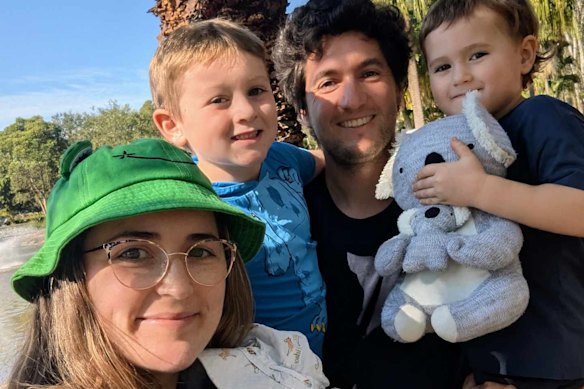Ashleigh and Wyatt could help end the ‘baby recession’. They have to win the lotto first
By Millie Muroi and Shane Wright
Cost-of-living pressures are continuing to put a dampener on baby fever in Australia, with the latest bounceback in births across the nation lagging pre-pandemic levels, especially in the major cities.
Despite inflation easing to 2.4 per cent in the March quarter – down from its peak of nearly 8 per cent in 2022 – analysis from KPMG Australia shows price pressures are continuing to deter many people from starting or expanding their families.

Ashleigh and Wyatt Galea with two of their three children, Henry and Oliver.Credit:
High school teacher Ashleigh Galea and her husband, electrician Wyatt Galea, both 31, already have three children but say they would have had at least one more if they could afford it.
“My husband and I have always joked that if we had the money, or won the lotto, he would like us to have a team worth of children,” Ashleigh said. “We’re lucky to be living in our own home, but even with both us working full-time, we still can’t afford luxuries like a cook or cleaner, which would make it easier to have had a larger family.”
Data from the Australian Bureau of Statistics shows that in the past 12 months, the total number of births in Australia was 292,500, up 2.6 per cent from the previous year but still 3.8 per cent lower than the 304,000 births recorded in 2019 before the pandemic.
That has kept Australia’s fertility rate – the average number of children over a woman’s lifetime – well below the 2.1 replacement rate needed to maintain the size of the population without migration. In 2024, Australia’s fertility rate was 1.51.
KPMG urban economist Terry Rawnsley said while there was an initial recovery in the number of births following lockdowns, largely because of low unemployment and substantial government stimulus, that trend was short-lived.
“Rising cost-of-living pressures in 2022 and 2023 triggered a significant ‘baby recession’, with births dropping by 5.1 per cent during that time,” he said.
Rawnsley said that rising rents, mortgage payments and childcare costs had put a handbrake on people’s plans to have children, especially in cities.
“Instead, regional communities are continuing to emerge as popular places to live, work and raise a family, with affordability now top of mind for many Australians,” he said.
While Sydney’s fertility rate is steadily falling, KPMG analysis shows the outer suburbs are leading the bounceback in births. “Sydney’s booming west is proving the perfect place to raise a family, with many of these areas offering bigger backyards and the same amenities as suburbs closer to the city, for just a fraction of the price,” he said.
The Galea family, who gave up a honeymoon to buy their first home nine years ago, recently moved further west in Sydney, towards the Blue Mountains.
“When we started looking at trying to buy a bigger house to get more space, we were looking in areas like Blacktown ... but we couldn’t afford to get anything that we wanted,” Ashleigh said.
“Even with both of us working pretty decent jobs, we couldn’t afford to keep our first home as an investment, so we had no choice but to sell in order to upgrade to one with more space for the three kids.”
The fertility rate in Sydney was 1.54 last year – slightly higher than the national average of 1.51.
Meanwhile, Melbourne’s fertility rate fell to 1.4 over the past year, the lowest among Australia’s major cities. The number of births in the past year was 8.2 per cent lower than pre-pandemic.
“Melbourne has really struggled to stabilise its fertility rate since the pandemic,” Rawnsley said. “The city did not have a post-COVID spike in births like most other cities, possibly because its lockdowns were more protracted than both Sydney and Brisbane.”
Like Sydney, however, Melbourne’s outer suburbs are recording the largest numbers of births in the city, with lower-density areas with larger homes having the highest fertility rates.
Perth and Brisbane have higher fertility rates than the country’s biggest cities. Perth’s fertility rate rebounded to 1.63 in 2024, up from 1.58 in 2023, bucking the trend of other cities.
“Perth’s relatively strong fertility rate is driven by the fact its housing market is still much more affordable compared to the east coast,” Rawnsley said.
While the number of births is still well short of the 350,000 needed each year to maintain the country’s natural population, Rawnsley said the growth in household incomes last year could see the birth rate recover.
“Those with a little more cash in the bank are now turning their attention to having a family again,” he said. “The baby bounceback is absolutely on, with [births] set to reach 300,000 over the next year.”
Cut through the noise of federal politics with news, views and expert analysis. Subscribers can sign up to our weekly Inside Politics newsletter.